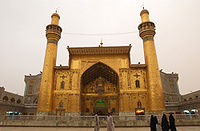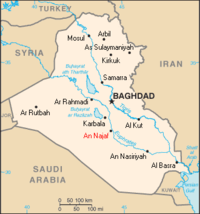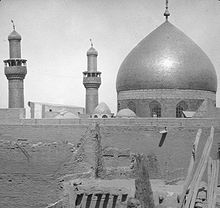- Najaf
-
For other uses, see Najaf (disambiguation).
An Najaf
النجفImam Ali's Shrine. The location of Najaf (printed in red) within Iraq. Coordinates: 32°00′00″N 44°20′00″E / 32°N 44.3333333°E Country  Iraq
IraqProvince Najaf Governorate Elevation 60 m (200 ft) Population (2008) – Total 560,000 Approximate figures[1] Time zone GMT +3 – Summer (DST) +4 (UTC) Najaf (Arabic: النجف; BGN: An Najaf) is a city in Iraq about 160 km south of Baghdad. Its estimated population in 2008 is 560,000 people.[1] It is the capital of Najaf Governorate. It is widely considered the third holiest city of Shi'a Islam and the center of Shia political power in Iraq.
Contents
Religious significance
Najaf is renowned as the site of the tomb of Alī ibn Abī Tālib also known as "Imām Alī"the First Imam of Shia's , the cousin and son-in-law of the prophet Muhammad whom the Shia consider to be the righteous caliph . The city is now a great center of pilgrimage from throughout the Shi'a Islamic world. It is estimated that only Mecca and Medina receive more Muslim pilgrims. As the burial site of Shia Islam's second most important figure,[2] the Imam Ali Mosque is considered by Shias as the third holiest Islamic site.[2][3][4][5][6][7][8][9][10]
The Imam Ali Mosque is housed in a grand structure with a gold gilded dome and many precious objects in the walls. Nearby is the Wadi-us-Salaam cemetery, reputed to be the largest in the world.[11] It contains the tombs of several prophets and many of the devout from around the world aspire to be buried here, to be raised from the dead with Imām Alī on Judgement Day. Over the centuries, numerous hospices, schools, libraries and Sufi convents were built around the shrine to make the city the centre of Shīʻa learning and theology.
The Najaf seminary is one of the most important teaching centres in the Islamic world. Ayatollah Khomeini lectured there from 1964-1978.[1] Many of the leading figures of the new Islamic movement that emerged in Iraq, Iran and Lebanon in the 1970s had studied at Najaf.[12]
Much of Najaf's heritage was badly damaged during the rule of Saddam Hussein, with a highway being driven through the middle of the Wādī'u s-Salām.
History
The Najaf area is located 30 km south of the ancient city of Babylon and 400 km north of the ancient Biblical city of Ur. The city itself was reputedly founded in 791 by the Abbasid Caliph Harūn ar-Rashīd, as a shrine to Ali ibn Abi Talib.[13]
Ali ibn Abi Talib instructed that his burial place should remain a secret as he had many enemies and he feared that his body might be subjected to some indignity. According to legend the dead body of Ali was placed on a camel which was driven from Kufa. The camel stopped a few miles west of the city and here the body was secretly buried. No tomb was raised and nobody knew of the burial place except for a few trusted people.
It is narrated that more than a hundred years later the Abbasid Caliph, Harun al-Rashid, went deer hunting outside Kufa and the deer sought sanctuary at a place where the hounds would not pursue it. On inquiry as to why the place was a sanctuary Harūn ar-Rashīd was told that it was the burial place of Ali. Harūn ar-Rashīd ordered a mausoleum to be built on the spot and in due course the town of Najaf grew around the mausoleum.
Under the rule of the Ottoman Empire Najaf experienced severe difficulties as the result of repeated raids by Arab desert tribes and Persian army and acute water shortages caused by the lack of a reliable water supply. The number of inhabited houses in the city had plummeted from 3000 to just 30 by the start of the 16th century.
When the Portuguese traveller Pedro Texeira passed through Najaf in 1604, he found the city in ruins, inhabited by little more than 500 people.[14]
The city was besieged by the Wahhabis in the late 18th century, which prompted the clergy of the city to arrange for the construction of a wall around the city and under-ground tunnels as a refuge for the women and children if the wall was over-run. These fortifications successfully repelled a Wahhabi siege later on. The water shortages were finally resolved in 1803 with the construction of the Hindiyya canal, following which the city's population rapidly doubled from 30,000 to 60,000.
The Ottomans were expelled in an uprising in 1915, following which the city fell under the rule of the British Empire. The sheikhs of Najaf rebelled in 1918, killing the British governor of the city by Sayed Mahdi Al-Awadi and cutting off grain supplies to the Anaza, a tribe allied with the British. In retaliation the British besieged the city and cut off its water supply. The rebellion was put down and the rule of the sheikhs was forcibly ended. A great number of the Shia ulema were expelled into Persia/Iran where they set the foundations for the rise of the city of Qom as the center of the Shia learning and authority in lieu of Najaf. Najaf lost its religious primacy to Qom and was not to regain it until the 21st century and the establishment of a Shia-majority government in Iraq after 2003.
Saddam Hussein period
Najaf was regarded with suspicion by the Sunnī-dominated regime of Saddam Hussein, which suppressed and restricted Shia religious activities. At the end of the Gulf War in 1991, people revolted against the regime's suppression and the destruction that it led the country into. This was put down by the Iraqi military with severe brutality and damage to the city, damaging the golden dome, slaughtering several innocent people who took refuge in the shrine and causing several others to disappear. Much of the damage was not repaired after several years, which was considered to be a collective punishment.
In February 1999, One of Najaf's most senior clerics, Muħammad Sādiq as-Sadr, was assassinated along with his two sons on the way from Baghdad to Najaf - the third killing of Shiite clerics in less than a year. Although the Iraqi government claimed to have caught and executed the supposed killers, there was evidence that Saddam's regime carried out the assassination, especially since it occurred in a country with very tight security and surveillance. One of his surviving sons, Moqtada al-Sadr, has assumed a prominent political role, mostly after the 2003 Iraq war, despite his relative paucity of formal theological credentials.
Post-Saddam Hussein period
During the 2003 invasion of Iraq, Najaf was a key target of the invading United States forces. The city was encircled during heavy fighting on March 26, 2003 and was captured on April 3, 2003 by 1st, 2nd, 3rd Battalions, 327th Infantry Regiment, units of the 101st Airborne Division.
 The Imām Alī Mosque, an important shrine in Najaf
The Imām Alī Mosque, an important shrine in Najaf
The clerical authorities of the Shīa enclave of Sadr City in Baghdad, which claimed autonomy in April 2003 after the fall of Baghdad, claimed to be taking their orders from senior clerics in Najaf.
On April 10, 2003 Sayyid Abdul Majid al-Khoei the son of Sayyid Abul-Qassim Al-Khoei was stabbed to death outside the Imam Ali Mosque by an angry mob.
On August 29, 2003 a car bomb exploded during prayers outside the Imām Alī Mosque just as weekly prayers were ending. More than 80 people were killed, including the influential cleric Ayatollah Sayyid Muħammad Bāqir al-Ħakīm, the Shīia leader of the Supreme Council for the Islamic Revolution in Iraq (SCIRI). Dozens of others were injured. Nobody claimed responsibility for the attack - Saddam himself, in hiding at the time, denied any involvement in a taped message.
On April 4, 2004, the Mahdi Army attacked the Spanish-Salvadoran-ALARNG base (Camp Golf, later renamed Camp Baker) in An Najaf, part of a coordinated uprising across central and southern Iraq in an apparent attempt to seize control of the country ahead of the June 30, 2004 handover of power to a new Iraqi government.
This uprising led to the 1st Armored Division's Task Force 2nd Battalion, 37th Armor (2-37 AR) attached to the 2 Armored Cavalry Regiment (2ACR) arriving in the city in the wake of the Spanish withdrawal. The situation aroused grave concerns among the Shia community of Iraq and Iran, as firefights took place within yards of the Kufa Mosque. Some mosques suffered superficial damage in the process, mostly due to Mahdi Army fighters mishandling explosives stored in the Kufa Mosque.
Firefights between the Mahdi Army and Badr Organization took place in May as tensions rose over the Mahdi Army's occupation of the Imam Ali Shrine, looting of the mosques in their control, and controversial prisons and Sharia courts. The Najaf cemetery, the largest cemetery in the world, became a battle ground in May 2004 as M1A1 tanks from 2-37 AR fought Mahdi Army soldiers on the outskirts of the cemetery. The Mahdi Army stationed several three man rocket propelled grenade RPG teams in the cemetery, who lived in large tombs to avoid detection from U.S. helicopters and UAVs.
In August 2004, heavy fighting broke out again between American troops of the 11th Marine Expeditionary Unit, the 1st Cavalry Division's 1st Battalion, 5th Cavalry Regiment and 2nd Battalion, 7th US Cavalry Regiment, 15th Forward Support Battalion and Al-Sadr's Mahdi Army. The battle, which was mostly centered around Wādī' as-Salām Cemetery and the southwestern portion of the city, lasted three weeks and ended when senior Iraqi cleric Grand Ayatollah Alī Al-Sīstānī negotiated an end to the fighting. During the aforementioned 3 week period Camp Golf, which occupied a very small fooprint at the site of the unfinished Kufah University, received over 165 mortar hits. Many US citizens working for contractor KBR admirably maintained the camp before, during, and after the 22 days of direct mortar hits. Also during that period several fire-fights occurred, some of which were friendly fire. One significant direct hit obliterated the fuel depot, which had contained a combined 90,000 gallons of JP-8, diesel, and gasoline fuels.
The evening before Al-Sistani arrived in the city, two F-16's, flying out of Balad, dropped four two-thousand pound JDAMs (Joint Direct Attack Munitions) on two hotels in close proximity to the Imam Ali Shrine. The success of this airstrike dealt a devastating blow to the Mahdi Army soldiers holed up in one of the holiest shrines in the Islamic faith.[citation needed]
See also
- Battle of Najaf (2003)
- Battle of Najaf (2004)
- Battle of Najaf (2007)
- Al Najaf International Airport
- List of places in Iraq
References
- ^ a b c Ring, Trudy (1996). "Najaf". Global Security. http://www.globalsecurity.org/military/world/iraq/najaf.htm. Retrieved 2009-09-13.
- ^ a b Never Again! ShiaNews.com
- ^ Iran Diary, Part 2: Knocking on heaven's door Asia Times Online
- ^ Muslim Shia's Saint Imam Ali Holy Shrine - 16 Images Cultural Heritage Photo Agency
- ^ The tragic martyrdom of Ayatollah Al Hakim calls for a stance Modarresi News, September 4, 2003
- ^ Zaman Online, August 13, 2004
- ^ Why 2003 is not 1991 The Guardian, April 1, 2003
- ^ Iraqi forces in Najaf take cover in important Shia shrine, The Boston Globe, April 2, 2003. "For the world's nearly 120 million Muslim Shias, Najaf is the third holiest city behind Mecca and Medina in Saudi Arabia."
- ^ Religious rivalries and political overtones in Iraq CNN.com, April 23, 2003]
- ^ "Miscellaneous Relevant Links" Muslims, Islam, and Iraq]
- ^ Hala Mundhir Fattah; Frank Caso (2009). A brief history of Iraq. Infobase Publishing. p. 140. ISBN 9780816057672. http://books.google.com/books?id=Q_-hrXU-mWYC&pg=PA140. Retrieved 18 October 2010.
- ^ Mallat, Chibli (2004). The Renewal of Islamic Law: Muhammad Baqer As-Sadr, Najaf and the Shi'i International. Cambridge University Press. http://books.google.fr/books?id=5oB4_tohQegC. Retrieved 2009-09-13.
- ^ Ring, Trudy (1996). International Dictionary of Historic Places: Middle East and Africa. Taylor & Francis. http://books.google.fr/books?id=R44VRnNCzAYC&pg=RA1-PA69I. Retrieved 2009-09-13.
- ^ Nakash, Yitzhak (2003). The Shi'is of Iraq. Princeton University Press. http://books.google.fr/books?id=BXJqeTr6p78C&pg=PA20&lpg=PA20. Retrieved 2009-09-13.
External links
Coordinates: 32°00′N 44°20′E / 32.00°N 44.33°E
Districts of Iraq and capitals Al Anbar Governorate Al Muthanna Governorate Al-Khidhir District (Al-Khidhir) • Al-Rumaitha District (Al-Rumaitha) • Al-Salman District (Al-Salman) • Al-Samawa District (Samawa)Al-Qādisiyyah Governorate Afaq District (Afaq) • Al-Shamiya District (Al-Shamiya) • Diwaniya District (Diwaniya) • Hamza District (Hamza)Babil Governorate Al-Mahawil District (Al-Mahawil) • Al-Musayab District (Al-Musayab) • Hashimiya District (Hashimiya) • Hilla District (Hilla)Baghdad Governorate Basra Governorate Abu Al-Khaseeb District (Abu Al-Khaseeb) • Al-Midaina District (Al-Midaina) • Al-Qurna District (Al-Qurna) • Al-Zubair District (Al-Zubair) •
Basrah District (Basrah) • al-Faw District (al-Faw) • Shatt Al-Arab District (Shatt Al-Arab)Dhi Qar Governorate Al-Chibayish District (Al-Chibayish) • Al-Rifa'i District (Al-Rifa'i) • Al-Shatra District (Al-Shatra) • Nassriya District (Nassriya) • Suq Al-Shoyokh District (Suq Al-Shoyokh)Diyala Governorate Dohuk Governorate Amadiya District (Amadiya) • Dohuk District (Dohuk)• Sumel District (Sumel) • Zakho District (Zakho)Arbil Governorate Makhmur District (Makhmur) • Arbil • Koisanjaq District (Koisanja) • Shaqlawa District (Shaqlawa)• Soran District • Mergasur District • Choman DistrictKarbala Governorate Ain Al-Tamur District (Ain Al-Tamur) • Al-Hindiya District (Al-Hindiya) • Kerbala District (Kerbala)Kirkuk Governorate Maysan Governorate Ali Al-Gharbi District (Ali Al-Gharbi) • Al-Kahla District (Al-Kahla) • Al-Maimouna District (Al-Maimouna) • Al-Mejar Al-Kabi District (Al-Mejar Al-Kabi) • Amara District (Amarah) • Qal'at Saleh District (Qal'at Saleh)Najaf Governorate Al-Manathera District (Al-Manathera) • Kufa District (Kufa) • Najaf District (Najaf)Ninawa Governorate Aqrah District (Aqrah) • Al-Ba'aj District (Al-Ba'aj) • Al-Hamdaniya District (Bakhdida) • Hatra District (Hatra) •Mosul District (Mosul) • Shekhan District (Ain Sifni) • Sinjar District (Sinjar) • Tel Afar District (Tel Afar) • Tel Keppe District (Tel Keppe)Salah ad Din Governorate Al-Daur District (Al-Daur) • Al-Shirqat District (Al-Shirqat) • Baiji District (Baiji) • Balad District (Balad) • Samarra District (Samarra) • Tikrit District (Tikrit) • Tooz District (Tooz)Sulaymaniyah Governorate Chamchamal District (Chamchamal) • Darbandokeh District (Darbandokeh) • Dokan District (Dokan) • Halabja District (Halabja) • Kalar District (Kalar) • Penjwin District (Penjwin) • Pshdar District (Pshdar) • Ranya District (Ranya) • Sharbazher District (Sharbazher) • Sulaymaniya District (Sulaymaniya)Wasit Governorate Al-Hai District (Al-Hai) • Al-Na'maniya District (Al-Na'maniya) • Al-Suwaira District (Al-Suwaira) • Badra District (Badra) • Kut District (Kut)Categories:- Najaf
- Populated places established in the 8th century
- 791 establishments
- Holy cities
- Shi'a holy cities
- Fertile Crescent
- District capitals of Iraq
- Cities in Iraq
Wikimedia Foundation. 2010.



